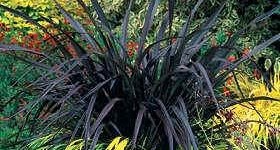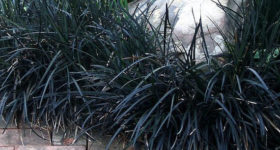For those who appreciate the unique beauty of a black Victorian garden or gothic garden you may wish to carry over the theme to include a black vegetable garden. Black vegetables are those that are so dark purple or red in color that they almost appear to be black. They provide the unique, dark look while still providing you with an abundance of healthy, tasty veggies you can enjoy all season long. To have a successful black vegetable garden, there are a few things to keep in mind such as how to put the garden together, what plants to include, and how to organize the vegetables for practical reasons as well as appearance.
Putting A Black Vegetable Garden Together
When putting together your black vegetable gardens, keep in mind what plants you would like to use and their various heights. It helps to plan your garden out on paper before you actually start working on it. Keeping similar plants in the same area of the garden is a good idea, along with making sure to provide trellises and cages for those plants which require support or climb as they grow. If you wish to make a separate area for your black vegetable garden, create a visual boundary by using edging materials, rocks, etc. Mulch the garden with natural material such as straw to control weeds and mud as well as keep the garden looking neat and tidy. The straw will also help conserve moisture for the plants. Keep your garden weeded regularly and remove any plants that you suspect might have a disease so that they do not spread to the remaining healthy plants.
What To Plant In Your Black Vegetable Garden
There are a few different tomatoes that are “black” varieties, as well as eggplant, lettuces, bell peppers, carrots, and squash that fall into this category.
The Black Beauty Eggplant is an heirloom variety that thrives in full sun and should be planted and staked or caged. Plants reach a height of 18 to 24 inches tall. Fruits ripen much earlier than other eggplant varieties. With its dark purple, almost black color, this is a perfect choice for a black vegetable. Buy from Burpee Gardening (items that say add to cart are from Burpee).
&
&
Black Cherry Tomatoes are a great choice for the black vegetable garden with their clusters of dark red tomatoes with a blackish hue. Plants produce an abundance of one inch tomatoes with a complex, sweet flavor. Great to use in salads or as a healthy snack.
&
&
The Rare Black Beauty Bell Pepper is a perfect choice for the black vegetable garden and really does appear to be black in color. Start your plants from natural, organic seeds that are not genetically modified. Plants produce large peppers with thick flesh.
Black Beauty Bell Pepper Seeds
Black Hawk Leaf Lettuce is the very darkest of all the leaf lettuce varieties. The red leaves are so dark they can appear black in color. Great for the black garden theme and really adds contrast when mixed with other lettuce varieties in a salad.
Indigo Black Tomatoes are a super dark variety that blooms from early summer through late summer. Plants produce cocktail sized tomatoes with overtones of a plum taste. This would be considered to be a medium sized tomato.
Saavyseeds Indigo Black Tomato Seeds – 35 Count – Organically Grown
Black Beauty Squash is another black vegetable garden staple to enjoy all summer long. The green-black zucchini have white flesh and should be picked when six to eight inches long. Plants prefer sunny locations.
&
&
The Black Knight Carrot is a very dark, almost black color, with a firm texture and mild flavor. Inside of the carrots are deep purple and white. Carrots grow to be six to eight inches long and are slightly tapered. These carrots have a sweet flavor and will compliment a salad make from the black lettuce and black tomatoes.
How To Organize Your Garden
Now that your garden has been planned out and the plants chosen, now you need to decide how to wish to organize them. Using the plants mentioned above as examples, if we were planting these we would place all of the tomato varieties in the same area of the garden. Make sure to cage each plant so that it has support and won’t spread all over and take up more room than necessary. Place each separate variety of tomato in its own space within the tomato section of the garden.The bell peppers and the eggplant are other plants which will require caging or staking, so placing them next to the tomatoes would be a likely choice.
Arrange them neatly in the garden so that you have an organized look with all of the caged plants near each other, and further divided into sections based on type of plant, then if applicable, varieties of same vegetable. This not only makes the garden look good, it helps when harvesting so that you know exactly what plant is where and they are not intermingling with each other. You might plant them in a row, or in designated sections of the garden.
The lettuce is a vegetable that needs to be planted individually and takes up more space on the ground. This is why it is effective and space saving to plant this type of vegetable in rows. Creating a long row across the span of the garden area will take up less space than designating a squared section of land for planting lettuces. This holds true for the carrots as well. Plant the lettuce in a long row and then plant the carrots in front of them in a long row. Re-plant a seed for every carrot or lettuce you pick to keep your crop coming all growing season.
When organizing your black vegetable garden, it is up to you as to whether you wish to plant your caged and trellised plants in rows or in sections within the garden. The general rule of thumb is to plant with other similar plants. This would mean tall with tall, medium with medium, tomatoes with other tomato varieties, etc. There are several ways that work well, so really take the time to plan it out so that you can make the most of your garden space, while at the same time showcasing your plants.


















Speak Your Mind